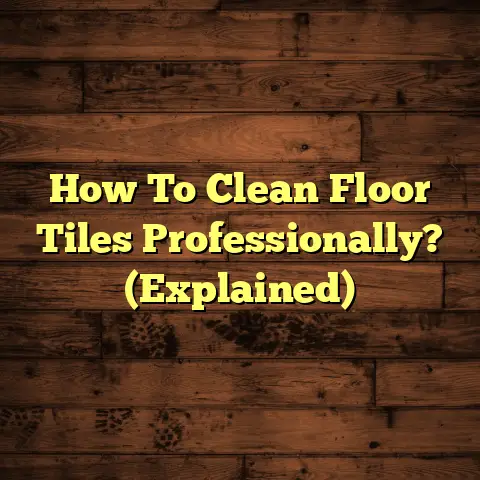Will Underlayment Level My Floor? (7 Subfloor Lies!)
(Image: A split image showing a perfectly level floor on one side and a visibly uneven floor on the other. Caption: Is underlayment the solution to your flooring woes?)
Let me tell you, I’ve seen it all – from floors that look like rollercoasters to homeowners convinced underlayment is a magical fix.
Today, we’re tackling a common misconception: Will underlayment level my floor?
Spoiler alert: it’s usually not the miracle cure you might think.
Let’s dive into the world of underlayment, floor leveling, and debunk some myths that could save you a lot of time, money, and frustration.
Section 1: Understanding Underlayment
So, what is underlayment, anyway?
Think of it as the unsung hero beneath your beautiful new floor. It’s a layer of material installed between the subfloor (that’s the structural floor beneath) and the finished flooring.
Its primary functions are to:
- Provide a smooth surface: It helps even out minor imperfections in the subfloor.
- Add cushioning: It makes the floor more comfortable to walk on.
- Reduce noise: It absorbs sound, making your home quieter.
- Provide thermal insulation: It helps keep your floors warmer.
- Moisture barrier: Some underlayments protect against moisture.
There’s a whole buffet of underlayment types out there, each with its own strengths and weaknesses. Here are a few common ones:
- Foam: This is the most common and affordable option. It’s lightweight, easy to install, and provides decent cushioning and sound absorption.
- Cork: A natural and sustainable option. It’s excellent for sound insulation and provides good thermal insulation. It’s also naturally resistant to mold and mildew.
- Rubber: Offers superior sound and impact absorption. It’s often used in multi-family dwellings or areas where noise is a concern.
- Felt: Often made from recycled materials, felt underlayment provides good cushioning and sound absorption. It’s also a good choice for radiant heating systems.
Now, how does underlayment play with different flooring types?
Well, it depends.
- Laminate: Laminate flooring requires underlayment. Many laminate floors even come with pre-attached underlayment.
- Hardwood: Underlayment is generally recommended for hardwood, especially for floating hardwood floors.
- Tile: Tile typically doesn’t use a traditional underlayment. Instead, a decoupling membrane might be used to prevent cracks.
I always tell my clients to check the flooring manufacturer’s recommendations for the best type of underlayment to use. Trust me, it can save you headaches down the road!
Section 2: The Concept of Floor Leveling
Okay, let’s talk about what it really means to have a “level” floor.
A level floor is a surface that is perfectly horizontal, or as close to it as possible.
Why is this so important?
- Aesthetics: Nobody wants furniture that wobbles or floors that look visibly uneven.
- Structural integrity: Uneven floors can put stress on the flooring material and the subfloor, leading to premature wear and tear.
- Proper installation: Many flooring materials, like tile and some hardwood, require a level surface for proper installation. Otherwise, you’ll end up with cracked tiles or uneven planks.
So, how do we achieve this elusive “level” floor? Here are some common methods:
- Self-leveling compound: This is a cement-based mixture that you pour onto the subfloor. It flows to fill in low spots and create a level surface as it dries.
- Floor joist adjustments: For more significant leveling issues, especially in older homes, you might need to shim or sister the floor joists. This is a more involved process that often requires a professional.
Now, here’s the key takeaway: Underlayment cannot fix major leveling issues.
While it can smooth out minor imperfections, it’s not designed to compensate for significant dips or slopes.
Think of it like this: underlayment is like a thin blanket. It can smooth out a few wrinkles, but it won’t fix a lumpy mattress.
Section 3: The Seven Lies About Subfloors
Alright, let’s get down to brass tacks and bust some myths! These are the lies I hear most often from homeowners, and they can lead to some serious flooring fails.
1. Lie #1: Underlayment Can Completely Level Your Floor
This is the biggest misconception of them all!
Underlayment can smooth out minor imperfections, like small bumps or dips less than, say, 1/8 of an inch over a 6-foot span.
But if you have a floor that’s significantly out of level, underlayment is not going to solve the problem.
What it can do: Provide a slight cushion and minimize minor irregularities.
What it can’t do: Correct major slopes, dips, or unevenness.
I’ve seen homeowners try to use thick underlayment to compensate for seriously uneven floors, and it always ends in disaster.
The flooring will eventually sag, crack, or become unstable.
2. Lie #2: All Subfloors Are Created Equal
Oh, how I wish this were true! Subfloors come in all shapes, sizes, and conditions.
You might have a perfectly smooth and level concrete slab, or you might have a bouncy, squeaky plywood subfloor with years of wear and tear.
Different subfloor materials:
- Concrete: Can be prone to cracking and moisture issues.
- Plywood: Susceptible to water damage and can warp or delaminate.
- OSB (Oriented Strand Board): Similar to plywood but generally less expensive and more prone to swelling when exposed to moisture.
The condition of your subfloor will significantly impact the effectiveness of your underlayment and the overall success of your flooring project.
A proper subfloor is vital for a long lasting floor.
3. Lie #3: You Can Skip Subfloor Preparation
Never, ever skip subfloor preparation!
This is one of the biggest mistakes I see homeowners make.
Think of it this way: you wouldn’t paint a dirty wall, right? The same principle applies to flooring.
Subfloor preparation typically involves:
- Cleaning: Removing all dirt, debris, and old adhesive.
- Repairing: Filling cracks, patching holes, and replacing damaged sections.
- Leveling: Addressing any significant unevenness with self-leveling compound.
- Sanding: Smoothing out any rough spots or imperfections.
If you skip these steps, you’re setting yourself up for problems down the road.
4. Lie #4: Underlayment Will Fix All Floor Problems
Underlayment is great, but it’s not a magic wand.
It can’t fix squeaky floors, eliminate moisture problems, or prevent mold growth.
Common floor problems underlayment won’t fix:
- Squeaky floors: Often caused by loose nails or screws in the subfloor.
- Moisture problems: Requires addressing the source of the moisture, such as leaks or poor ventilation.
- Mold growth: Requires professional remediation and addressing the underlying moisture issue.
5. Lie #5: Thicker Underlayment Equals Better Results
Not necessarily!
While thicker underlayment can provide more cushioning and sound absorption, it’s not always the best choice.
In some cases, thicker underlayment can actually worsen leveling problems.
It can also create a spongy feeling underfoot, which some people don’t like.
The key is to choose the right type and thickness of underlayment for your specific flooring and subfloor conditions.
6. Lie #6: Any Type of Underlayment Will Work for Any Floor
Nope! Compatibility is key.
Some underlayments are specifically designed for certain types of flooring.
For example, some underlayments are not compatible with radiant heating systems, while others are not suitable for use with tile.
Always check the flooring manufacturer’s recommendations and choose an underlayment that is specifically designed for your flooring type.
7. Lie #7: You Don’t Need to Measure Your Floor Before Installation
Big mistake!
Measuring your floor is crucial for determining the amount of underlayment you need, as well as for assessing any leveling issues.
Before you even think about installing underlayment, grab a level, a straight edge, and a measuring tape.
Check for any significant dips, slopes, or unevenness.
This will help you determine whether you need to level the floor before installing underlayment.
Section 4: Real-Life Scenarios and Case Studies
Let me share a couple of stories from my years in the field to illustrate these points.
Case Study 1: The Laminate Disaster
I had a client who was convinced that a thick foam underlayment would fix his severely uneven subfloor. He installed laminate flooring over it, and within a few months, the floor started to sag and buckle.
(Before Image: A photo of a laminate floor with visible sagging and buckling.)
(After Image: A photo of the same floor after being properly leveled and re-installed.)
I had to rip up the entire floor, level the subfloor with self-leveling compound, and reinstall the laminate with the correct underlayment. It was a costly and time-consuming mistake that could have been avoided with proper preparation.
Case Study 2: The Squeaky Hardwood
Another client complained about a squeaky hardwood floor. He thought underlayment would solve the problem.
However, the squeaks were caused by loose nails in the subfloor. I had to go through and secure the subfloor before installing new hardwood and underlayment.
Lesson learned: Underlayment is not a magic bullet for all floor problems.
Section 5: Tools and Techniques for Floor Leveling
So, you’ve determined that your floor needs leveling. What tools do you need, and what techniques should you use?
Essential Tools:
- Level: A 4-foot level is ideal for checking for unevenness.
- Straight Edge: A long, straight piece of wood or metal can help you identify dips and slopes.
- Measuring Tape: For measuring the dimensions of the room and calculating the amount of leveling compound needed.
- Self-Leveling Compound: Choose a high-quality self-leveling compound that is designed for your specific subfloor material.
- Mixing Bucket and Drill with Mixing Paddle: For mixing the self-leveling compound.
- Spiked Roller: To remove air bubbles from the self-leveling compound.
Leveling Techniques:
- Assess the Floor: Use a level and straight edge to identify high and low spots.
- Prepare the Subfloor: Clean the subfloor thoroughly and repair any cracks or holes.
- Prime the Subfloor: Apply a primer to the subfloor to improve the adhesion of the self-leveling compound.
- Mix the Self-Leveling Compound: Follow the manufacturer’s instructions carefully.
- Pour the Compound: Pour the self-leveling compound onto the subfloor, starting at the lowest point.
- Spread the Compound: Use a trowel to spread the compound evenly and ensure that it covers all the low spots.
- Remove Air Bubbles: Use a spiked roller to remove any air bubbles from the compound.
- Allow to Dry: Allow the compound to dry completely before installing underlayment and flooring.
Important Note: For major leveling issues or if you’re not comfortable working with self-leveling compound, it’s always best to consult a professional.
Section 6: Expert Opinions and Insights
I’m not the only one who feels this way about underlayment! I reached out to some other flooring experts to get their take on the topic.
Quote from Sarah Jones, Flooring Contractor:
“I always tell my clients that underlayment is like makeup. It can enhance the appearance of a good foundation, but it can’t hide serious flaws.”
Quote from Mark Thompson, Flooring Inspector:
“I see so many flooring failures that are directly related to improper subfloor preparation. People try to cut corners, and it always comes back to bite them.”
Emerging Trends:
One trend I’m seeing is the use of adjustable floor supports. These are small, adjustable pedestals that you can place under the subfloor to level it.
They’re particularly useful for older homes with uneven joists.
Section 7: Conclusion
So, will underlayment level your floor?
The answer, as you now know, is usually no.
While underlayment plays a vital role in flooring installations, it’s not a substitute for proper subfloor preparation and leveling.
Don’t fall for the lies!
- Underlayment is not a magic fix for uneven floors.
- All subfloors are not created equal.
- You cannot skip subfloor preparation.
- Thicker underlayment is not always better.
- You do need to measure your floor before installation.
Call to Action
Take a closer look at your flooring situation. Is your floor truly level? Is your subfloor in good condition?
If you’re unsure, don’t hesitate to seek professional advice.
And now, I’d love to hear from you! Share your own experiences with underlayment and floor leveling in the comments below.
What challenges have you faced, and what solutions have you found? Let’s learn from each other and make sure everyone gets the beautiful, level floors they deserve!





